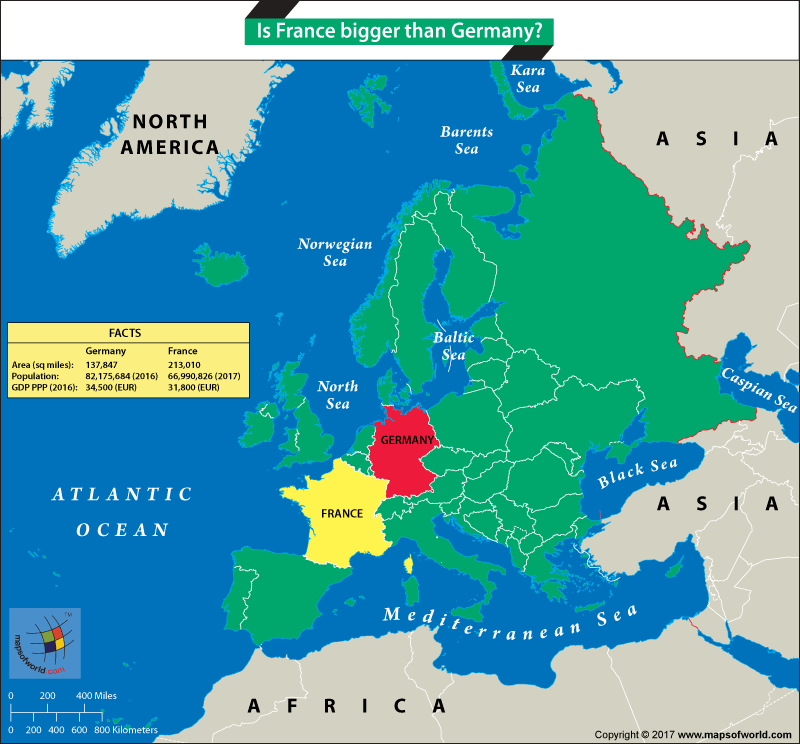

Europe Map highlighting France and Germany
Yes. France is bigger than Germany.
France is the largest country in the European Union by land area. Metropolitan France, the part that lies in Europe, covers 213,010 sq miles; Germany covers 137,847 sq miles.
In terms of population, Germany with a population of 82,175,684 (2016) is bigger than France that has a population count of 66,990,826 (Jan, 2017). In comparison to the rest of EU members, Germany has a share of 16.1% of the population; France 13.1%. In population density per square kilometer, Germany stands higher at 228.6 (2015); France 105.3 (2015).
In per capita GDP (2016), Germany is higher at EUR 34,500 compared to France’s EUR 31,800. Due to this, the number of asylum seekers in 2016 was higher in Germany than France; Germany attracted 745,155 applicants; France 84,270.
The government gross debt of GDP (2016) in France was at 96%, higher than Germany which was at 68.3%. In 2016, the unemployment rate in France was 6.1% which was higher than Germany at 2.8%.
In international trade (2016), German export turnover stood at EUR 1,209,623.80 million; France EUR 452,820.80 million. In percentage export to EU countries as a share of total export, France held a larger share at 59.4%; Germany 58.5%.
In total imports, Germany was higher at EUR 953,097.40 million; France EUR 517,475.60 million. In percentage export to EU countries as a share of total imports, France was higher at 69.1%; Germany 66.4%.
In overall trade balance in 2016, Germany showed a positive balance at EUR 256,526.50 million; France EUR -64,654.80 million.
On Research and Development (R&D), Germany exceeded France in total expenditure as a percentage of GDP at 2.87%; France 2.23%.
On education, the public expenditure on education (2011) as a percentage of GDP was higher in France at 5.68%; Germany 4.98%. But employment rates of graduates (2016) was higher in Germany at 90.2%; France 71.7%.
On transportation and related infrastructure, Germany was ahead of France on the total length of railway line network and motorways. Germany had 23,472 Mi of railway lines (2014); France 18,012 Mi (2015). Consequently in 2016, Germany transported higher tonnage of goods by rail at 367,314 thousand tonnes; France 95,545 thousand tonnes.
In motorways, Germany had 8,073 Mi; France 7,207 Mi. Consequently in 2015, Germany transported higher tonnage of goods by road at 3,035,329 thousand tonnes; France 1,796,755 thousand tonnes.
In 2016, on Gross Value Added (GVA) by the agriculture industry, France outperformed Germany. The industry in France generated EUR 25,554.31 million; Germany EUR 13,550.26 million.
In cow milk production (2016), Germany produced 31,879.13 thousand tonnes; France 25,323.23 thousand tonnes. However, in bovine meat production the same year, France produced 1,461.72 thousand tonnes; Germany 1,133 thousand tonnes.
In fisheries (live catch- 2015), France did better at 497,435.05 tonnes; Germany 251,268.49 tonnes. However, in overall aquaculture production, Germany turned in better figures at 26,867.4 tonnes; France 180,344 tonnes.
In 2015, Germany outperformed France as a tourist destination with more tourists heading for Germany than France. Germany attracted 247,875,946 tourists; France attracted 199,156,667 tourists. The average expenditure per tourist was EUR 461.91 in Germany; France EUR 353.45.
Note: Russia has been excluded as it straddles Europe and Asia and is also not a member of European Union.
Related Maps:
The Republic of Madagascar is an island country located in the Indian Ocean, off the…
The Euro is the official currency of the European Union. It is, however, not incumbent…
There are many countries or regions that are partially recognized by the UN, have disputes…
The Alaska Statehood Act was signed into law by President Dwight D. Eisenhower in 1958,…
The name Persia may, however, only be used to refer to Iran in some contexts.…
Hawaii is an Island State in the US. It is one of the 50 states…